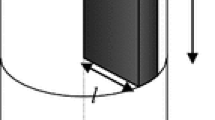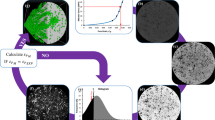Abstract
The model of pressure solution for granular aggregate was introduced into the FEM code for analysis of thermo-hydro-mechanical (T-H-M) coupling in porous medium. Aiming at a hypothetical nuclear waste repository in an unsaturated quartz rock mass, two computation conditions were designed: 1) the porosity and the permeability of rock mass are functions of pressure solution; 2) the porosity and the permeability are constants. Then the corresponding numerical simulations for a disposal period of 4 a were carried out, and the states of temperatures, porosities and permeabilities, pore pressures, flow velocities and stresses in the rock mass were investigated. The results show that at the end of the calculation in Case 1, pressure solution makes the porosities and the permeabilities decrease to 10%–45% and 0.05%-1.4% of their initial values, respectively. Under the action of the release heat of nuclear waste, the negative pore pressures both in Case 1 and Case 2 are 1.2–1.4 and 1.01–1.06 times of the initial values, respectively. So, the former represents an obvious effect of pressure solution. The magnitudes and distributions of stresses within the rock mass in the two calculation cases are the same.
Similar content being viewed by others
References
YASUHARA H, ELSWORTH D, POLAK A. A mechanistic model for compaction of granular aggregates moderated by pressure solution [J]. J Geophys Res, 2003, 108(B11): 2530.
TENTHOREY E, COX S, TODD H. Evolution of strength recovery and permeability during fluid-rock reaction in experimental fault zones [J]. Earth and Plane Sci Lett, 2003, 206: 161–172.
MOORE E, LOCKNER A, BYERLEE D. Reduction of permeability in granite at elevated temperatures [J]. Science, 1994, 265: 1558–1561.
LIN W, ROBERTS J, GLASSLEY W, RUDDLE D. Fracture and matrix permeability at elevated temperatures [C]// Workshop on Significant Issues and Available Data, Near-field/Altered-zone Coupled Effects Expert Elicitation Project. San Francisco, 1997.
POLAK A, ELSWORTH D, YASUHARA H, GRADER A, HALLECK P. Permeability reduction of a natural fracture under net dissolution by hydrothermal fluids [J]. Geophys Res Lett, 2003, 30(20), 2020, doi: 10.1029/2003GL017575.
DURHAM W, BOURCIER W, BURTON E. Direct observation of reactive flow in a single fracture [J]. Water Resour Res, 2001, 37: 1–12.
YASUHARA H, ELSWORTH D. Evolution of permeability in a natural fracture: Significant role of pressure solution [J]. J Geophys Res, 2004, 109, B03204, doi: 10.1029/2003JB002663.
YASUHARA H, ELSWORTH D. Compaction of a rock fracture moderated by competing roles of stress corrosion and pressure solution [J]. Pure Appl Geophys, 2008, 165: 1289–1306.
TARON J, ELSWORTH D. Coupled mechanical and chemical processes in engineered geothermal reservoirs with dynamic permeability [J]. International Journal of Rock Mechanics and Mining Sciences, 2010, 47: 1339–1348.
TARON J, ELSWORTH D. Constraints on compaction rate and equilibrium in the pressure solution creep of quartz aggregates and fractures: Controls of aqueous concentration [J]. Journal of Geophysical Research, 2010, 115: B07211. doi:10.1029/ 2009JB007118.
ZHANG Yu-jun, ZHANG Wei-qing. 3D thermo-hydro-mechanical model and finite element analyses of dual-porosity fractured medium for ubiquitous-joint rock mass [J]. Sci China Tech Sci, 2010, 53(8): 2172–2182.
ZHANG Yu-jun, YANG Chao-shuai. Coupled hermo-hydro-mechanical-migratory model for dual-porosity medium and numerical analysis [J]. Journal of Central South University of Technology, 2011, 18(4): 1256–1262.
ZHANG Yu-jun, ZHANG Wei-qing, YANG Chao-shuai. FEM analyses for influences of stress corrosion and pressure solution on THM coupling in dual-porosity rock mass [J]. Sci China Tech Sci, 2011, 54(7): 1748–1756.
YASUHARA H, ELSWORTH D, POLAK A, JISHAN L, GRADER A, HALLECK P. Spontaneous switching between permeability enhancement and degradation in fractures in carbonate: Lumped parameter representation of mechanically-and chemically-mediated dissolution [J]. Transport in Porous Media, 2006, 65: 385–409.
LEE D, ELSWORTH D, YASUHARA H, WEAVER J, RICKMAN R. Experiment and modeling to evaluate the effects of proppant-pack diagenesis on fracture treatments [J]. Journal of Petroleum Science and Engineering, 2006, 74: 67–76.
ELIAS P, HAJASH A. Change in quartz solubility and porosity change due to effective stress: An experimental investigation of pressure solution [J]. Geology, 1992, 20: 451–454.
CHIJIMATSU M, KURIKAMI H, ITO A, SUGITA Y. Implication of THM coupling on the near-field of a nuclear waste repository in a homogeneous rock mass [R]. Tokyo: DECOVALES III-Task3-Bench Mark Test 1(BMT1)-Subtask BMT1-B, 2002: 1–43.
Author information
Authors and Affiliations
Corresponding author
Additional information
Foundation item: Project(2010CB732101) supported by the National Basic Research Program of China; Project(51079145) supported by the National Natural Science Foundation of China; Project(2009BAK53B03) supported by the National Key Technology R&D Program of China
Rights and permissions
About this article
Cite this article
Zhang, Yj., Yang, Cs. FEM analyses for influences of pressure solution on thermo-hydro-mechanical coupling in porous rock mass. J. Cent. South Univ. 19, 2333–2339 (2012). https://doi.org/10.1007/s11771-012-1279-8
Received:
Accepted:
Published:
Issue Date:
DOI: https://doi.org/10.1007/s11771-012-1279-8




